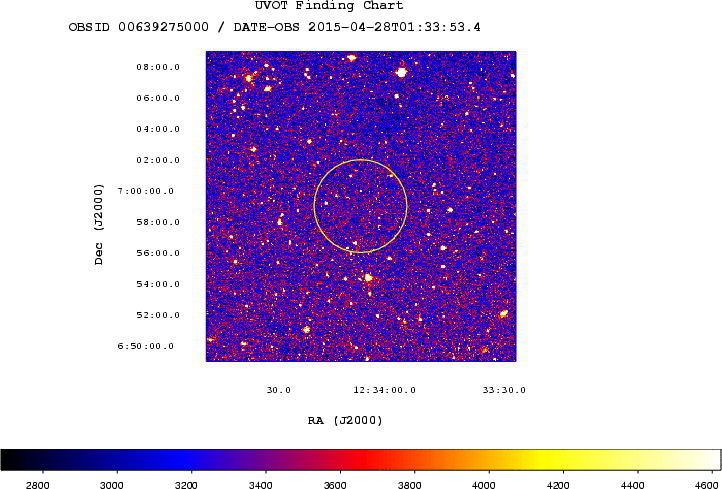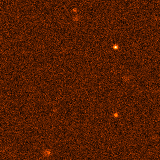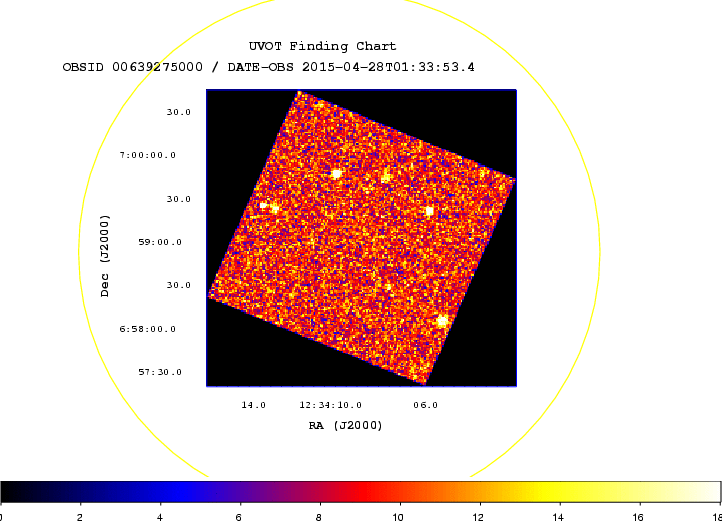(All information courtesy of the instrument teams.)
![]() Previous IAU Circulars
Previous IAU Circulars
TITLE: GCN/SWIFT NOTICE
NOTICE_DATE: Tue 28 Apr 15 01:31:42 UT
NOTICE_TYPE: Swift-BAT GRB Position
TRIGGER_NUM: 639275, Seg_Num: 0
GRB_RA: 188.543d {+12h 34m 10s} (J2000),
188.738d {+12h 34m 57s} (current),
187.907d {+12h 31m 38s} (1950)
GRB_DEC: +6.981d {+06d 58' 51"} (J2000),
+6.896d {+06d 53' 47"} (current),
+7.256d {+07d 15' 23"} (1950)
GRB_ERROR: 3.00 [arcmin radius, statistical only]
GRB_INTEN: 32842 [cnts] Image_Peak=657 [image_cnts]
TRIGGER_DUR: 12.160 [sec]
TRIGGER_INDEX: 491 E_range: 50-350 keV
BKG_INTEN: 137147 [cnts]
BKG_TIME: 5346.49 SOD {01:29:06.49} UT
BKG_DUR: 64 [sec]
GRB_DATE: 17140 TJD; 118 DOY; 15/04/28
GRB_TIME: 5440.83 SOD {01:30:40.83} UT
GRB_PHI: 36.79 [deg]
GRB_THETA: 43.71 [deg]
SOLN_STATUS: 0x10103
RATE_SIGNIF: 29.83 [sigma]
IMAGE_SIGNIF: 12.63 [sigma]
MERIT_PARAMS: +1 +0 +0 +4 +3 +2 +0 +0 +83 +0
SUN_POSTN: 35.11d {+02h 20m 27s} +14.00d {+14d 00' 06"}
SUN_DIST: 146.51 [deg] Sun_angle= -10.2 [hr] (East of Sun)
MOON_POSTN: 151.09d {+10h 04m 22s} +8.21d {+08d 12' 40"}
MOON_DIST: 37.33 [deg]
MOON_ILLUM: 69 [%]
GAL_COORDS: 290.65, 69.44 [deg] galactic lon,lat of the burst (or transient)
ECL_COORDS: 185.06, 9.80 [deg] ecliptic lon,lat of the burst (or transient)
COMMENTS: SWIFT-BAT GRB Coordinates.
COMMENTS: This is a rate trigger.
COMMENTS: A point_source was found.
COMMENTS: This position matches one of the nearby galaxy sources in the
+on-board catalog!
COMMENTS: This does not match any source in the on-board catalog.
COMMENTS: This matches a source in the ground catalog: I3521, delta=0.211 [deg].
COMMENTS: This is a GRB in nearby galaxy or it is noise.
COMMENTS: This trigger occurred at longitude,latitude = 16.92,19.05 [deg].

TITLE: GCN/SWIFT NOTICE
NOTICE_DATE: Tue 28 Apr 15 01:31:56 UT
NOTICE_TYPE: Swift-BAT Transient Position
TRIGGER_NUM: 639275, Seg_Num: 0
GRB_RA: 188.543d {+12h 34m 10s} (J2000),
188.738d {+12h 34m 57s} (current),
187.907d {+12h 31m 38s} (1950)
GRB_DEC: +6.981d {+06d 58' 51"} (J2000),
+6.896d {+06d 53' 47"} (current),
+7.256d {+07d 15' 23"} (1950)
GRB_ERROR: 3.00 [arcmin radius, statistical only]
GRB_INTEN: 32842 [cnts] Image_Peak=657 [image_cnts]
TRIGGER_DUR: 12.160 [sec]
TRIGGER_INDEX: 491 E_range: 50-350 keV
BKG_INTEN: 137147 [cnts]
BKG_TIME: 5346.49 SOD {01:29:06.49} UT
BKG_DUR: 64 [sec]
GRB_DATE: 17140 TJD; 118 DOY; 15/04/28
GRB_TIME: 5440.83 SOD {01:30:40.83} UT
GRB_PHI: 36.79 [deg]
GRB_THETA: 43.71 [deg]
SOLN_STATUS: 0x10103
RATE_SIGNIF: 29.83 [sigma]
IMAGE_SIGNIF: 12.63 [sigma]
MERIT_PARAMS: +1 +0 +0 +4 +3 +2 +0 +0 +83 +0
SUN_POSTN: 35.11d {+02h 20m 27s} +14.00d {+14d 00' 06"}
SUN_DIST: 146.51 [deg] Sun_angle= -10.2 [hr] (East of Sun)
MOON_POSTN: 151.09d {+10h 04m 23s} +8.21d {+08d 12' 38"}
MOON_DIST: 37.33 [deg]
MOON_ILLUM: 69 [%]
GAL_COORDS: 290.65, 69.44 [deg] galactic lon,lat of the burst (or transient)
ECL_COORDS: 185.06, 9.80 [deg] ecliptic lon,lat of the burst (or transient)
COMMENTS: SWIFT-BAT Transient Coordinates.
COMMENTS: This is a rate trigger.
COMMENTS: A point_source was found.
COMMENTS: This does not match any source in the on-board catalog.
COMMENTS: This matches a source in the ground catalog: I3521, delta=0.211
+[deg].
COMMENTS: This is not a GRB -- it is a hard x-ray transient.
COMMENTS: This trigger occurred at longitude,latitude = 16.92,19.05 [deg].
TITLE: GCN/SWIFT NOTICE
NOTICE_DATE: Tue 28 Apr 15 01:33:47 UT
NOTICE_TYPE: Swift-XRT Nack-Position
TRIGGER_NUM: 639275, Seg_Num: 0
POINT_RA: 188.570d {+12h 34m 17s} (J2000)
POINT_DEC: +6.953d {+06d 57' 12"} (J2000)
IMG_START_DATE: 17140 TJD; 118 DOY; 15/04/28
IMG_START_TIME: 5616.73 SOD {01:33:36.73} UT, 175.9 [sec] since BAT Trigger Time
COUNTS: 14 Min_needed= 20
STD_DEV: 0.00 Max_StdDev_for_Good=28.44 [arcsec]
PH2_ITER: 1 Max_iter_allowed= 4
ERROR_CODE: 1
COMMENTS: SWIFT-XRT Nack Position.
COMMENTS: No source found in the image.
TITLE: GCN/SWIFT NOTICE
NOTICE_DATE: Tue 28 Apr 15 01:36:48 UT
NOTICE_TYPE: Swift-UVOT Source List
TRIGGER_NUM: 639275, Seg_Num: 0
POINT_RA: 188.570d {+12h 34m 17s} (J2000)
POINT_DEC: +6.953d {+06d 57' 12"} (J2000)
POINT_ROLL: 308.500d
IMG_START_DATE: 17140 TJD; 118 DOY; 15/04/28
IMG_START_TIME: 5619.93 SOD {01:33:39.93} UT, 179.1 [sec] since BAT Trigger Time
FILTER: 10, White
BKG_MEAN: 2.254
N_STARS: 21
X_OFFSET: 743 [pixels]
Y_OFFSET: 459 [pixels]
X_MAX: 1702 [pixels]
Y_MAX: 1418 [pixels]
DET_THRESH: 12
PHOTO_THRESH: 6
SL_URL: sw00639275000msufc0179.fits
SUN_POSTN: 35.12d {+02h 20m 28s} +14.00d {+14d 00' 10"}
SUN_DIST: 146.54 [deg] Sun_angle= -10.2 [hr] (East of Sun)
MOON_POSTN: 151.13d {+10h 04m 32s} +8.20d {+08d 11' 57"}
MOON_DIST: 37.32 [deg]
MOON_ILLUM: 69 [%]
GAL_COORDS: 290.74, 69.42 [deg] galactic lon,lat of the pointing direction
ECL_COORDS: 185.10, 9.78 [deg] ecliptic lon,lat of the pointing direction
COMMENTS: SWIFT-UVOT Source List.
TITLE: GCN/SWIFT NOTICE
NOTICE_DATE: Tue 28 Apr 15 01:37:18 UT
NOTICE_TYPE: Swift-UVOT Processed Source List
TRIGGER_NUM: 639275, Seg_Num: 0
POINT_RA: 188.570d {+12h 34m 17s} (J2000)
POINT_DEC: +6.953d {+06d 57' 12"} (J2000)
POINT_ROLL: 308.500d
IMG_START_DATE: 17140 TJD; 118 DOY; 15/04/28
IMG_START_TIME: 5619.93 SOD {01:33:39.93} UT, 179.1 [sec] since BAT Trigger Time
FILTER: 10, White
BKG_MEAN: 2.254
N_STARS: 21
X_OFFSET: 743 [pixels]
Y_OFFSET: 459 [pixels]
X_MAX: 1702 [pixels]
Y_MAX: 1418 [pixels]
DET_THRESH: 12
PHOTO_THRESH: 6
SL_URL: sw00639275000msufc0179.fits
SUN_POSTN: 35.12d {+02h 20m 28s} +14.00d {+14d 00' 10"}
SUN_DIST: 146.54 [deg] Sun_angle= -10.2 [hr] (East of Sun)
MOON_POSTN: 151.14d {+10h 04m 33s} +8.20d {+08d 11' 53"}
MOON_DIST: 37.31 [deg]
MOON_ILLUM: 69 [%]
GAL_COORDS: 290.74, 69.42 [deg] galactic lon,lat of the pointing direction
ECL_COORDS: 185.10, 9.78 [deg] ecliptic lon,lat of the pointing direction
COMMENTS: SWIFT-UVOT Processed Source List.
COMMENTS: All 4 attachments are included.

TITLE: GCN/SWIFT NOTICE
NOTICE_DATE: Tue 28 Apr 15 01:38:22 UT
NOTICE_TYPE: Swift-UVOT Image
TRIGGER_NUM: 639275, Seg_Num: 0
POINT_RA: 188.570d {+12h 34m 17s} (J2000)
POINT_DEC: +6.953d {+06d 57' 12"} (J2000)
ROLL: 308.500d
IMG_START_DATE: 17140 TJD; 118 DOY; 15/04/28
IMG_START_TIME: 5619.93 SOD {01:33:39.93} UT, 179.1 [sec] since BAT Trigger Time
FILTER: 10, White
EXPOSURE_ID: 451877633
X_OFFSET: 1062 [pixels]
Y_OFFSET: 778 [pixels]
WIDTH: 160 [pixels]
HEIGHT: 160 [pixels]
X_GRB_POS: 1222
Y_GRB_POS: 938
BINNING_INDEX: 1
IM_URL: sw00639275000msuni0193.fits
SUN_POSTN: 35.12d {+02h 20m 28s} +14.00d {+14d 00' 11"}
SUN_DIST: 146.54 [deg] Sun_angle= -10.2 [hr] (East of Sun)
MOON_POSTN: 151.15d {+10h 04m 35s} +8.20d {+08d 11' 44"}
MOON_DIST: 37.31 [deg]
MOON_ILLUM: 69 [%]
GAL_COORDS: 290.74, 69.42 [deg] galactic lon,lat of the pointing direction
ECL_COORDS: 185.10, 9.78 [deg] ecliptic lon,lat of the pointing direction
COMMENTS: SWIFT-UVOT Image.
COMMENTS: The GRB Position came from the Window Position in the Mode Command.
COMMENTS: The image has 2x2 binning (compression).

TITLE: GCN/SWIFT NOTICE
NOTICE_DATE: Tue 28 Apr 15 01:38:31 UT
NOTICE_TYPE: Swift-UVOT Processed Image
TRIGGER_NUM: 639275, Seg_Num: 0
POINT_RA: 188.570d {+12h 34m 17s} (J2000)
POINT_DEC: +6.953d {+06d 57' 12"} (J2000)
ROLL: 308.500d
IMG_START_DATE: 17140 TJD; 118 DOY; 15/04/28
IMG_START_TIME: 5619.93 SOD {01:33:39.93} UT, 179.1 [sec] since BAT Trigger Time
FILTER: 10, White
EXPOSURE_ID: 451877633
X_OFFSET: 1062 [pixels]
Y_OFFSET: 778 [pixels]
WIDTH: 160 [pixels]
HEIGHT: 160 [pixels]
X_GRB_POS: 1222
Y_GRB_POS: 938
BINNING_INDEX: 1
IM_URL: sw00639275000msuni0193.fits
SUN_POSTN: 35.12d {+02h 20m 28s} +14.00d {+14d 00' 11"}
SUN_DIST: 146.54 [deg] Sun_angle= -10.2 [hr] (East of Sun)
MOON_POSTN: 151.15d {+10h 04m 35s} +8.20d {+08d 11' 43"}
MOON_DIST: 37.30 [deg]
MOON_ILLUM: 69 [%]
GAL_COORDS: 290.74, 69.42 [deg] galactic lon,lat of the pointing direction
ECL_COORDS: 185.10, 9.78 [deg] ecliptic lon,lat of the pointing direction
COMMENTS: SWIFT-UVOT Processed Image.
COMMENTS: The GRB Position came from the Window Position in the Mode Command.
COMMENTS: The image has 2x2 binning (compression).
COMMENTS: All 4 attachments are included.

RA(J2000) = 12h 34m 10s Dec(J2000) = +06d 58' 51"with an uncertainty of 3 arcmin (radius, 90% containment, including systematic uncertainty). The BAT light curve showed a complex structure with a duration of about 50 sec. The peak count rate was ~1700 counts/sec (15-350 keV), at ~17 sec after the trigger.
RA(J2000) = 12h 34m 09.33s Dec(J2000) = +06d 57' 07.6"with an uncertainty of 3.7 arcseconds (radius, 90% containment). This location is 105 arcseconds from the BAT onboard position, within the BAT error circle. This position may be improved as more data are received; the latest position is available at http://www.swift.ac.uk/sper.
RA = 12:34:09.26 Dec. = +06:57:08.7with an error of 0".5 in each coordinate.
g' = 24.1 +/- 0.4 mag, r' = 23.0 +/- 0.1 mag, i' = 22.7 +/- 0.1 mag, and z' = 23.2 +/- 0.2 mag.At this time, we cannot establish fading. At this position, we also detect a source in the SDSS, which implies that this would be the host galaxy of this GRB. We note the hydrogen column density as derived from X-rays (Page et al., GCN #17765) is much higher than the (very low) Galactic NH, implying this may be an optically dust-suppressed event.
RA (J2000): 12h 34m 9.31s Dec (J2000): +06d 57' 14.0"with an uncertainty of 1.9 arcsec (radius, 90% confidence).
r > 23.94 i > 23.90 z > 19.56These magnitudes are in the AB system and are not corrected for Galactic extinction in the direction of the GRB. We note that the source detected by GROND (Knust, et al., GCN 17767) and P60 (Perley, GCN 17769) is not consistent with the enhanced X-ray position. For the GROND source, in comparison with the SDSS DR9, we obtain the following detections and upper limit (3-sigma):
r = 23.41 +/- 0.22 i = 22.75 +/- 0.14 z > 19.56The RATIR observations of the GROND source, therefore, do not show evidence of fading between the GROND and RATIR epochs of observations. Further RATIR observations are ongoing.
R.A. = 12:34:09.227 Dec. = +6:57:14.07Error Radius: ~ 1 arcsec,
RA(J2000) = 12h 34m 09.3s=20 Dec(J2000) = +06d 58' 00.8=E2=80=9D=20with an uncertainty of 1.2 arcmin, (radius, sys+stat, 90% containment). The partial coding was 16%.
Total column: 5.3 (+2.4, -1.9) x 10^21 cm^-2 Galactic foreground: 1.6 x 10^20 cm^-2 Excess significance: 4.4 sigma Photon index: 2.0 (+0.4, -0.3)If the light curve continues to decay with a power-law decay index of 0.75, the count rate at T+24 hours will be 0.028 count s^-1, corresponding to an observed (unabsorbed) 0.3-10 keV flux of 1.2 x 10^-12 (1.9 x 10^-12) erg cm^-2 s^-1.
Date start T_s-T_tr T_m-T_trig Expt. Limit Coadd
(mean_time)
01:32:10.9 90 100 20 16.0 no
01:32:43.2 122 132 20 16.0 no
01:33:14.7 153 168 30 16.4 no
01:33:14.7 153 224 120 17.0 3
01:33:14.7 153 583 770 18.5 9
Also, we can not confirm Danish 1.56m OT (Andersen et. al GCN 17771),
because they do not see it on our images with upper limits specified
above.
Filter T_start(s) T_stop(s) Exp(s) UL (3-sigma) white_FC 179 329 147 >20.9 u 3572 3726 152 >19.9The magnitudes in the table are not corrected for the Galactic extinction due to the reddening of E(B-V) = 0.02 in the direction of the burst (Schlegel et al. 1998).
Date (UTC) | Telescope | Freq (GHz) | Peak Flux Density (uJy/beam) ------------------------------------------------------------------ 2019/12/05 | ASKAP | 1.4 | 363 +/- 56 2021/05/21 | ATCA | 5.5 | 94 +/- 26 2021/06/13 | uGMRT | 1.3 | 386 +/- 17The fitted position of the radio source from the uGMRT observation is
RA: 12:34:09.296 Dec: +06:57:13.83Observations of the radio source do not show any evidence for fading in epochs separated by 555 days and we therefore conclude the source is likely the host galaxy of GRB 150428A.